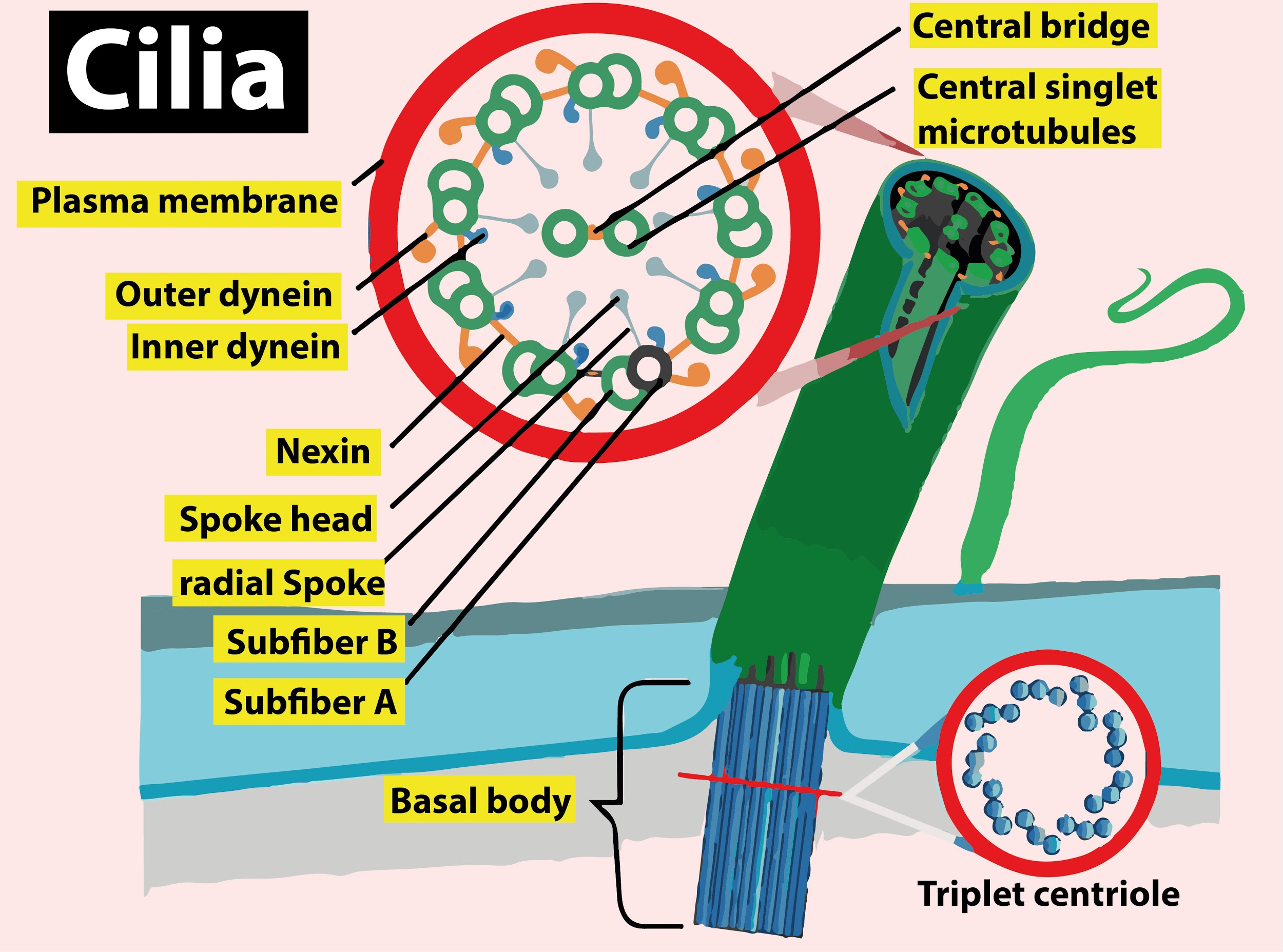
Axoneme with 9 + 2 microtubule arrangement occurs in
(a) Cilia
(b) Flagella
(c) Both A and B
(d) Centriole
Answer
574.2k+ views
Hint: Axoneme with 9 + 2 microtubule arrangement occurs in cellular appendages which helps in the functions related to locomotion of the organism or movement of any particles through its body. The axoneme forms their core in which protein filaments are arranged in a particular fashion.
Complete answer:
Eukaryotic flagella and cilia share a common structural organization of 9+2 arrangement. Their core is called an axoneme. The axoneme consists of nine pairs of microtubule doublets arranged peripherally with a central pair of singlet microtubules. These bundles of microtubules comprising the axoneme are surrounded by a plasma membrane. Each doublet microtubule consists of A and B tubules made up of protofilaments. They are linked through a protein named ‘tektin.’ Adjacent pairs of doublet microtubules are joined through a linker made up of a protein called ‘nexin.’ A second linker also radiates from the central singlets to each A tubule of the peripheral microtubules. These linkers are known as radial spokes.

So, the correct answer is ‘Both A and B.’
Additional Information:
- A flagellum has a wave-like motion driving a cell in the same direction as the axis of the flagellum. A cilium generates alternating power and recovery strokes. These strokes move a cell perpendicular to the axis of the cilium.
- Cilia are many in number as compared to flagellum and occur all over the surface of the cell. A flagellum is usually longer and only 1 - 4 per cell.
- A centriole is a barrel- shaped polarized structure made up of microtubules. They are present mostly in animal cells and some fungi but not in plant cells. The walls of each are composed of nine triplet microtubules arranged peripherally without any central microtubules. The central part of the centriole is proteinaceous and called the hub, which is connected with the peripheral triplets via radial spokes made up of protein. This is known as the 9 + 0 arrangement.
Note:
- The cell organelle centrosome contains these perpendicularly arranged centrioles surrounded with a centrosome matrix.
- Prior to mitosis in animal cells, centrioles duplicate in a centrosome and later in the M- phase migrate to opposite poles. They initiate the process of bipolar spindle synthesis wherein they give rise to spindle fibers during cell division. They also form the basal body of cilia or flagella.
Complete answer:
Eukaryotic flagella and cilia share a common structural organization of 9+2 arrangement. Their core is called an axoneme. The axoneme consists of nine pairs of microtubule doublets arranged peripherally with a central pair of singlet microtubules. These bundles of microtubules comprising the axoneme are surrounded by a plasma membrane. Each doublet microtubule consists of A and B tubules made up of protofilaments. They are linked through a protein named ‘tektin.’ Adjacent pairs of doublet microtubules are joined through a linker made up of a protein called ‘nexin.’ A second linker also radiates from the central singlets to each A tubule of the peripheral microtubules. These linkers are known as radial spokes.

So, the correct answer is ‘Both A and B.’
Additional Information:
- A flagellum has a wave-like motion driving a cell in the same direction as the axis of the flagellum. A cilium generates alternating power and recovery strokes. These strokes move a cell perpendicular to the axis of the cilium.
- Cilia are many in number as compared to flagellum and occur all over the surface of the cell. A flagellum is usually longer and only 1 - 4 per cell.
- A centriole is a barrel- shaped polarized structure made up of microtubules. They are present mostly in animal cells and some fungi but not in plant cells. The walls of each are composed of nine triplet microtubules arranged peripherally without any central microtubules. The central part of the centriole is proteinaceous and called the hub, which is connected with the peripheral triplets via radial spokes made up of protein. This is known as the 9 + 0 arrangement.
Note:
- The cell organelle centrosome contains these perpendicularly arranged centrioles surrounded with a centrosome matrix.
- Prior to mitosis in animal cells, centrioles duplicate in a centrosome and later in the M- phase migrate to opposite poles. They initiate the process of bipolar spindle synthesis wherein they give rise to spindle fibers during cell division. They also form the basal body of cilia or flagella.
Recently Updated Pages
The number of solutions in x in 02pi for which sqrt class 12 maths CBSE

Write any two methods of preparation of phenol Give class 12 chemistry CBSE

Differentiate between action potential and resting class 12 biology CBSE

Two plane mirrors arranged at right angles to each class 12 physics CBSE

Which of the following molecules is are chiral A I class 12 chemistry CBSE

Name different types of neurons and give one function class 12 biology CBSE

Trending doubts
One Metric ton is equal to kg A 10000 B 1000 C 100 class 11 physics CBSE

Explain zero factorial class 11 maths CBSE

What is 1s 2s 2p 3s 3p class 11 chemistry CBSE

Discuss the various forms of bacteria class 11 biology CBSE

State the laws of reflection of light

Difference Between Prokaryotic Cells and Eukaryotic Cells




